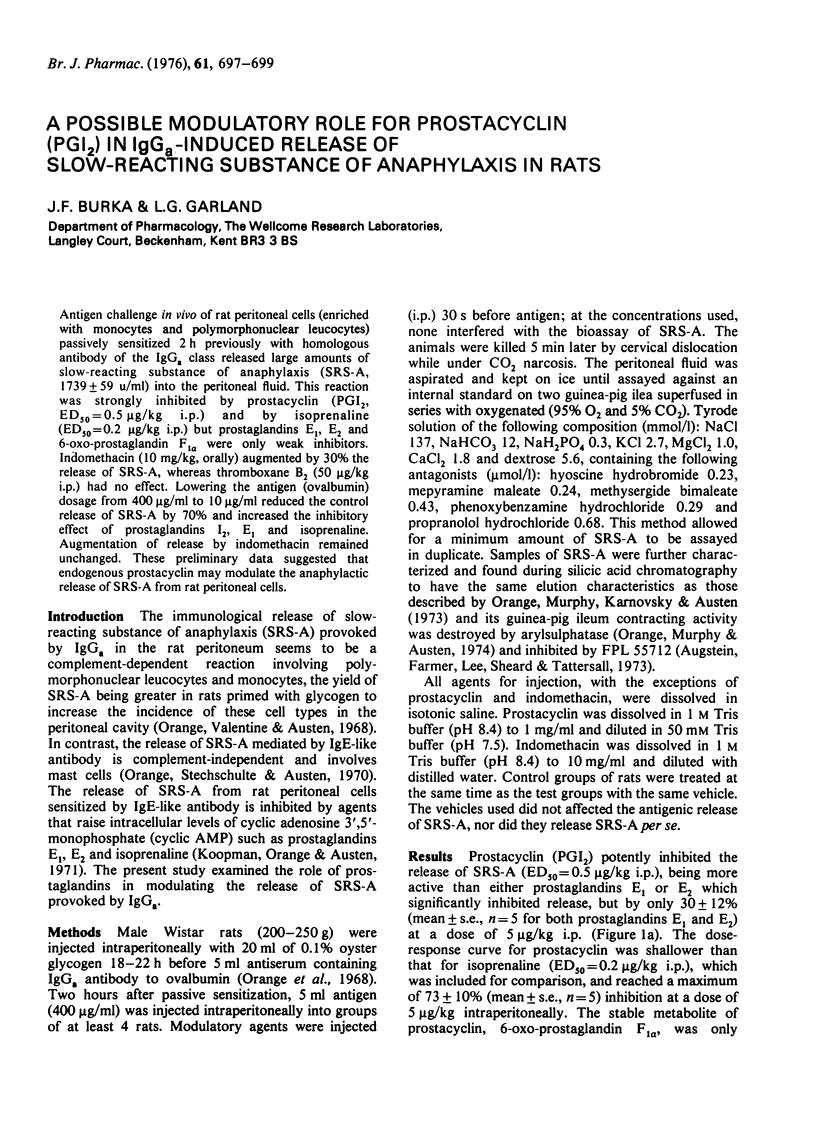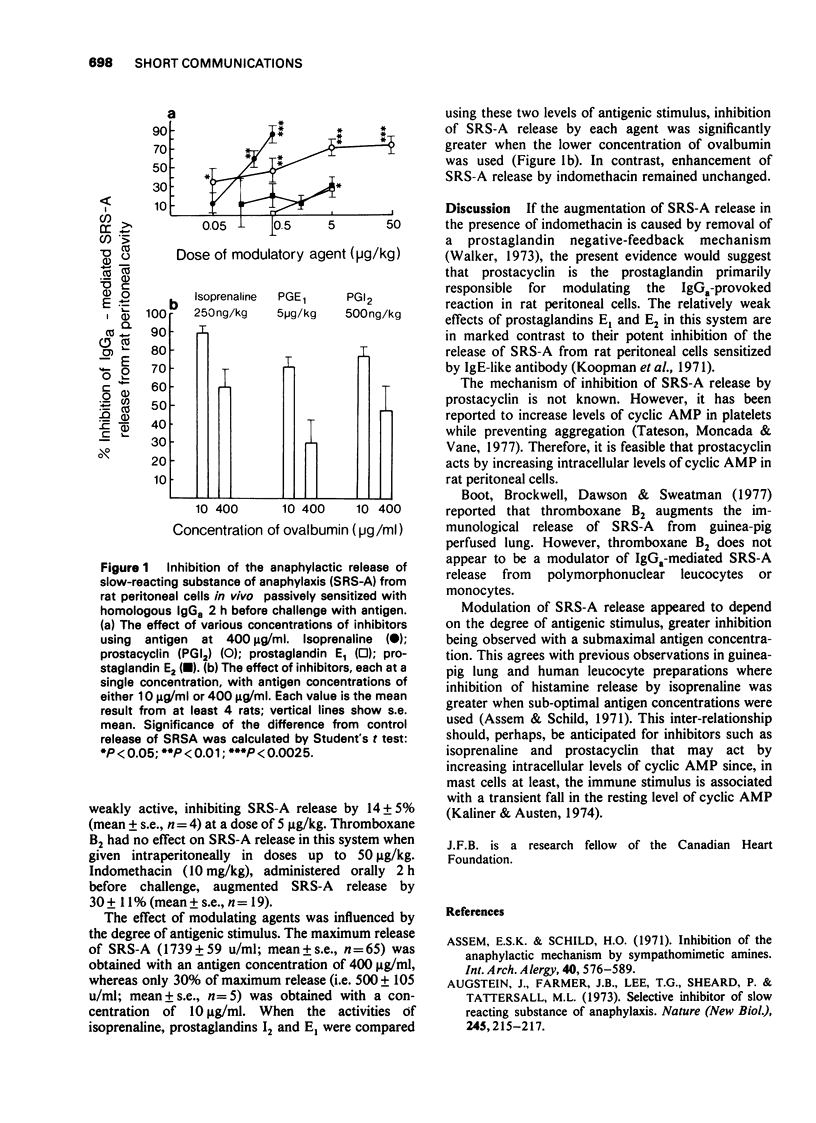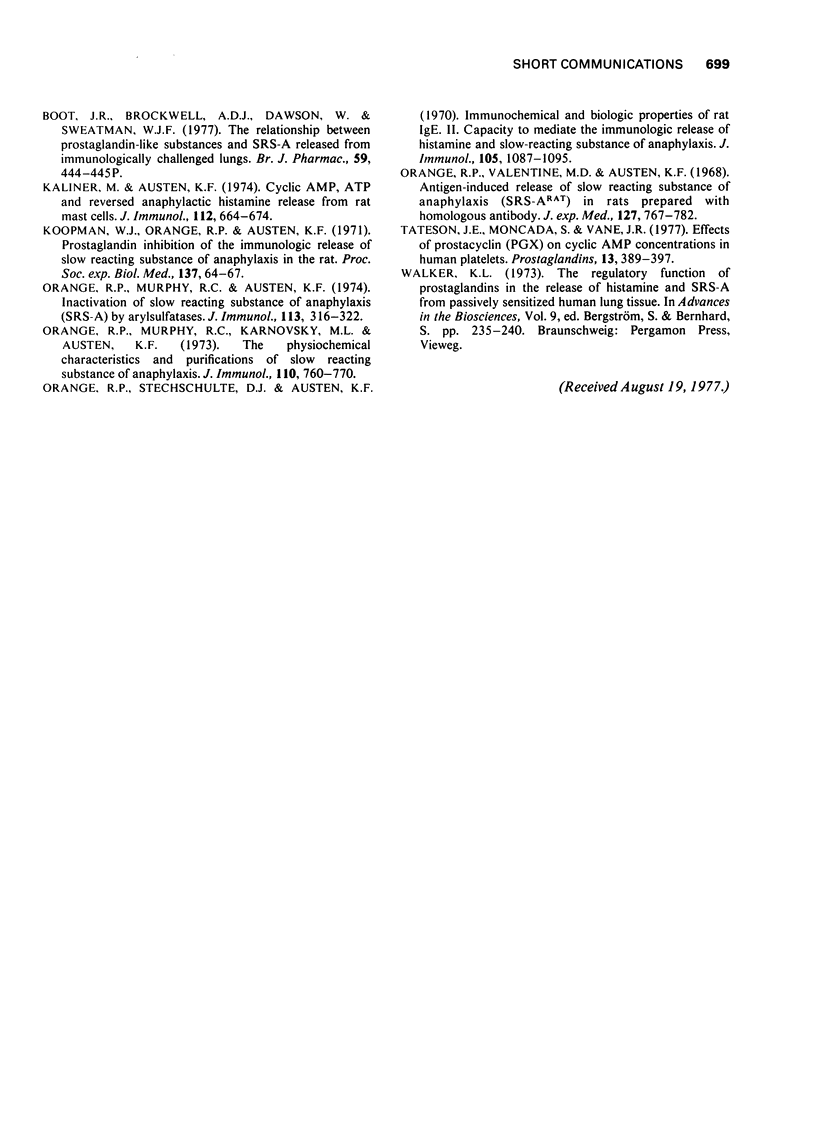Abstract
Antigen challenge in vivo of rat peritoneal cells (enriched with monocytes and polymorphonuclear leucocytes) passively sensitized 2 h previously with homologous antibody of the IgGa class released large amounts of slow-reacting substance of anaphylaxis (SRS-A, 1739 +/- 59 u/ml) into the peritoneal fluid. This reaction was strongly inhibited by prostacyclin (PGI2, ED50 = 0.5 microgram/kg i.p.) and by isoprenaline (ED50 = 0.2 microgram/kg i.p.) but prostaglandins E1, E2 and 6-oxo-prostaglandin F1alpha were only weak inhibitors. Indomethacin (10 mg/kg, orally) augmented by 30% the release of SRS-A, whereas thromboxane B2 (50 microgram/kg i.p.) had no effect. Lowering the antigen (ovalbumin) dosage from 400 microgram/ml to 10 microgram/ml reduced the control release of SRS-A by 70% and increased the inhibitory effect of prostaglandins I2, E1 and isoprenaline. Augmentation of release by indomethacin remained unchanged. These preliminary data suggested that endogenous prostacyclin may modulate the anaphylactic release of SRS-A from rat peritoneal cells.
Full text
PDF


Selected References
These references are in PubMed. This may not be the complete list of references from this article.
- Assem E. S., Schild H. O. Inhibition of the anaphylactic mechanism by sympathomimetic amines. Int Arch Allergy Appl Immunol. 1971;40(4-5):576–589. doi: 10.1159/000230439. [DOI] [PubMed] [Google Scholar]
- Augstein J., Farmer J. B., Lee T. B., Sheard P., Tattersall M. L. Selective inhibitor of slow reacting substance of anaphylaxis. Nat New Biol. 1973 Oct 17;245(146):215–217. doi: 10.1038/newbio245215a0. [DOI] [PubMed] [Google Scholar]
- Kaliner M., Austen K. F. Cyclic AMP, ATP, and reversed anaphylactic histamine release from rat mast cells. J Immunol. 1974 Feb;112(2):664–674. [PubMed] [Google Scholar]
- Koopman W. J., Orange R. P., Austen K. F. Prostaglandin inhibition of the immunologic release of slow reacting substance of anaphylaxis in the rat. Proc Soc Exp Biol Med. 1971 May;137(1):64–67. doi: 10.3181/00379727-137-35512. [DOI] [PubMed] [Google Scholar]
- Orange R. P., Murphy R. C., Austen K. F. Inactivation of slow reacting substance of anaphylaxins (SRS-A) by arylsulfatases. J Immunol. 1974 Jul;113(1):316–322. [PubMed] [Google Scholar]
- Orange R. P., Murphy R. C., Karnovsky M. L., Austen K. F. The physicochemical characteristics and purification of slow-reacting substance of anaphylaxis. J Immunol. 1973 Mar;110(3):760–770. [PubMed] [Google Scholar]
- Orange R. P., Stechschulte D. J., Austen K. F. Immunochemical and biologic properties of rat IgE. II. Capacity to mediate the immunologic releas of histamine an slow-reacting substance of anaphylaxis (SRS-A). J Immunol. 1970 Nov;105(5):1087–1095. [PubMed] [Google Scholar]
- Orange R. P., Valentine M. D., Austen K. F. Antigen-induced release of slow reacting substance of anaphylaxis (SRS-A rat) in rats prepared with homologous antibody. J Exp Med. 1968 Apr 1;127(4):767–782. doi: 10.1084/jem.127.4.767. [DOI] [PMC free article] [PubMed] [Google Scholar]
- Tateson J. E., Moncada S., Vane J. R. Effects of prostacyclin (PGX) on cyclic AMP concentrations in human platelets. Prostaglandins. 1977 Mar;13(3):389–397. doi: 10.1016/0090-6980(77)90019-3. [DOI] [PubMed] [Google Scholar]


